cruise control Acura TL 2000 3.2 Owner's Manual
[x] Cancel search | Manufacturer: ACURA, Model Year: 2000, Model line: TL, Model: Acura TL 2000Pages: 311, PDF Size: 3.05 MB
Page 6 of 311
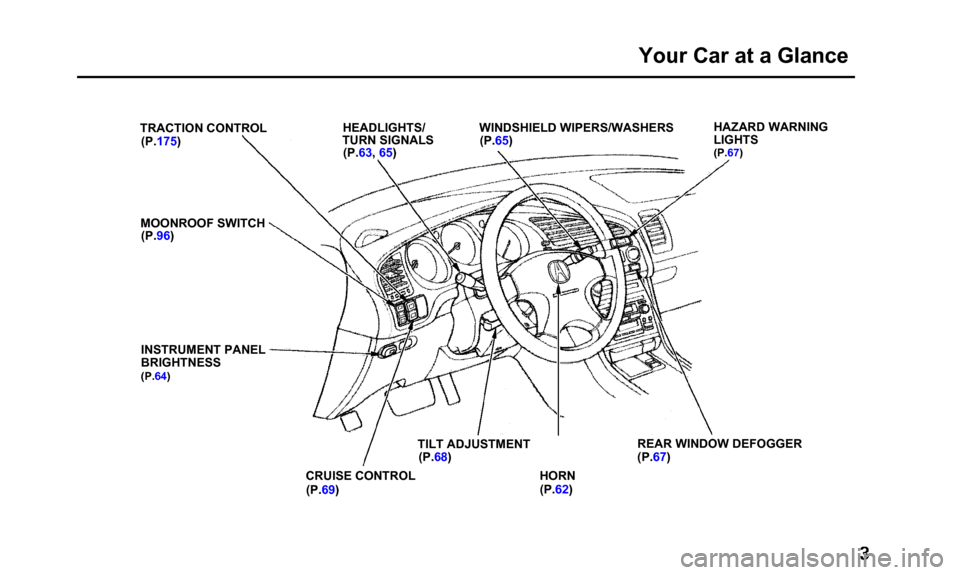
Your Car at a Glance
TRACTION CONTROL(P.175)
MOONROOF SWITCH (P.96)
INSTRUMENT PANEL
BRIGHTNESS
(P.64)
HEADLIGHTS/
TURN SIGNALS (P.63, 65) WINDSHIELD WIPERS/WASHERS
(P.65) HAZARD WARNING
LIGHTS
(P.67)
CRUISE CONTROL
(P.69) HORN
(P.62)
TILT ADJUSTMENT
(P.68) REAR WINDOW DEFOGGER
(P.67)
Page 54 of 311
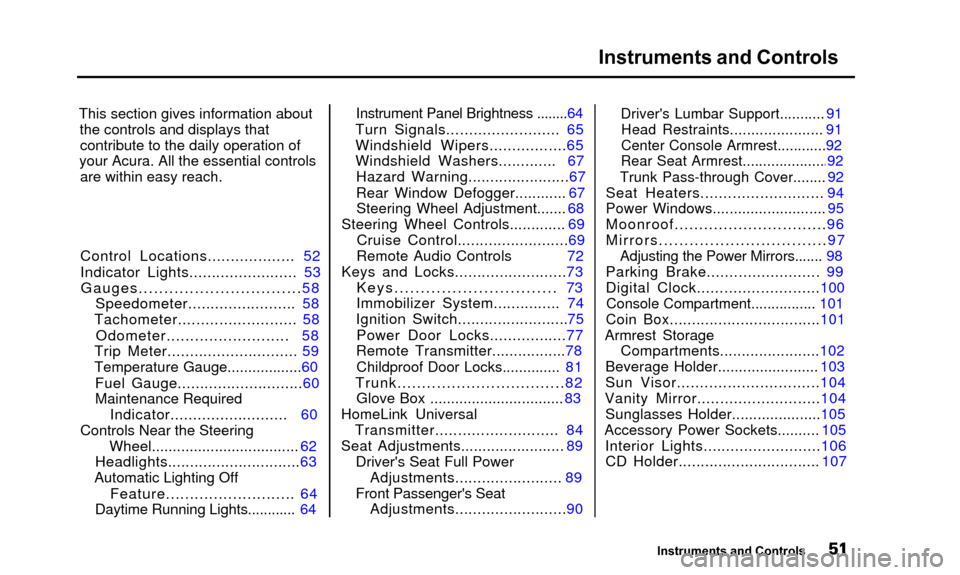
Instruments and Controls
This section gives information aboutthe controls and displays thatcontribute to the daily operation of
your Acura. All the essential controls are within easy reach.
Control Locations................... 52
Indicator Lights........................ 53
Gauges................................58
Speedometer........................ 58
Tachometer.......................... 58
Odometer.......................... 58
Trip Meter............................. 59
Temperature Gauge..................60
Fuel Gauge............................60
Maintenance Required Indicator.......................... 60
Controls Near the Steering
Wheel................................... 62
Headlights..............................63
Automatic Lighting Off
Feature........................... 64
Daytime Running Lights............ 64
Instrument Panel Brightness ........64
Turn Signals......................... 65
Windshield Wipers.................65
Windshield Washers............. 67 Hazard Warning....................... 67
Rear Window Defogger............ 67
Steering Wheel Adjustment....... 68
Steering Wheel Controls............. 69 Cruise Control.........................69
Remote Audio Controls 72
Keys and Locks.........................73
Keys............................... 73
Immobilizer System............... 74
Ignition Switch ......................... 75
Power Door Locks.................77
Remote Transmitter.................78
Childproof Door Locks.............. 81
Trunk.................................. 82
Glove Box ................................ 83
HomeLink Universal Transmitter........................... 84
Seat Adjustments........................ 89
Driver's Seat Full PowerAdjustments........................ 89
Front Passenger's Seat Adjustments.........................90
Driver's Lumbar Support........... 91Head Restraints...................... 91
Center Console Armrest............92
Rear Seat Armrest....................4 92
Trunk Pass-through Cover........ 92
Seat Heaters........................... 94
Power Windows........................... 95
Moonroof...............................96
Mirrors.................................97
Adjusting the Power Mirrors....... 98
Parking Brake......................... 99
Digital Clock...........................100
Console Compartment................ 101
Coin Box..................................101
Armrest Storage
Compartments.......................102
Beverage Holder........................ 103
Sun Visor...............................104
Vanity Mirror........................... 104
Sunglasses Holder.....................105
Accessory Power Sockets.......... 105
Interior Lights..........................106
CD Holder................................ 107
Instruments and Controls
Page 56 of 311
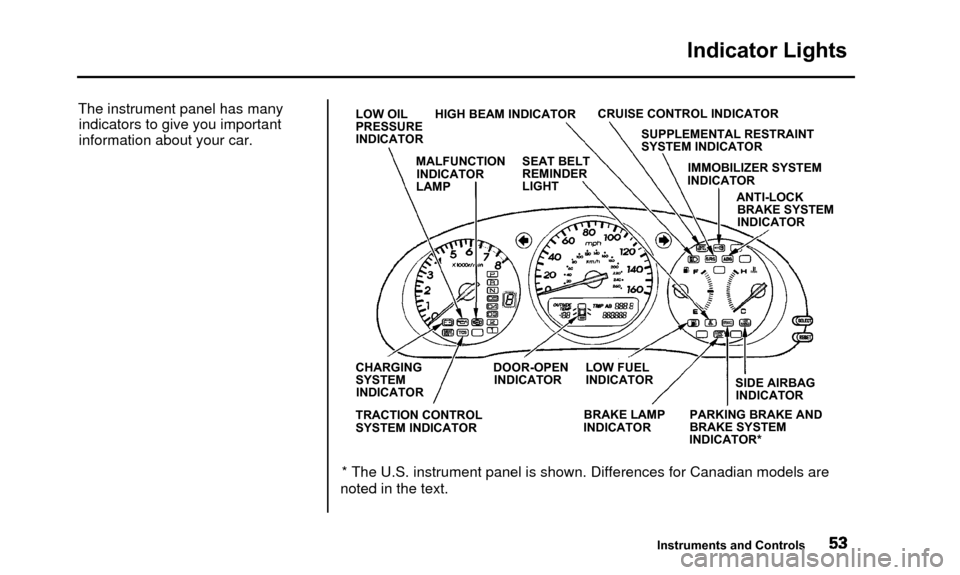
Indicator Lights
The instrument panel has manyindicators to give you important
information about your car.LOW OIL HIGH BEAM INDICATOR
PRESSURE
INDICATOR CRUISE CONTROL INDICATOR
SUPPLEMENTAL RESTRAINT
SYSTEM INDICATOR
IMMOBILIZER SYSTEM
INDICATOR
ANTI-LOCKBRAKE SYSTEM
INDICATOR
CHARGING DOOR-OPEN LOW FUEL
SYSTEM INDICATOR INDICATOR INDICATOR
TRACTION CONTROL
SYSTEM INDICATOR BRAKE LAMP
INDICATOR SIDE AIRBAG
INDICATOR
PARKING BRAKE AND
BRAKE SYSTEM
INDICATOR*
* The U.S. instrument panel is shown. Differences for Canadian models ar\
e
noted in the text.
Instruments and Controls
MALFUNCTION
INDICATOR
LAMP SEAT BELT
REMINDER
LIGHT
Page 60 of 311
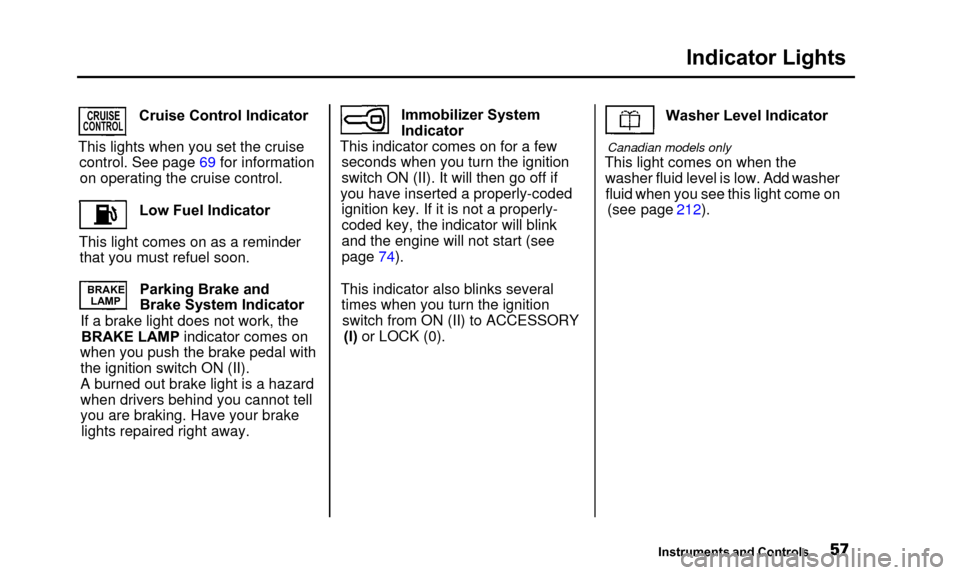
Indicator Lights
CRUISECONTROLCruise Control Indicator
This lights when you set the cruise control. See page 69 for informationon operating the cruise control.
Low Fuel Indicator
This light comes on as a reminder that you must refuel soon.
BRAKE LAMPParking Brake and
Brake System Indicator
If a brake light does not work, the BRAKE LAMP indicator comes on
when you push the brake pedal with the ignition switch ON (II).
A burned out brake light is a hazard
when drivers behind you cannot tell
you are braking. Have your brake lights repaired right away. Immobilizer System
Indicator
This indicator comes on for a few seconds when you turn the ignition
switch ON (II). It will then go off if
you have inserted a properly-coded ignition key. If it is not a properly-
coded key, the indicator will blink
and the engine will not start (see
page 74).
This indicator also blinks several times when you turn the ignition switch from ON (II) to ACCESSORY (I) or LOCK (0). Washer Level Indicator
Canadian models only
This light comes on when the
washer fluid level is low. Add washerfluid when you see this light come on (see page 212).
Instruments and Controls
Page 65 of 311
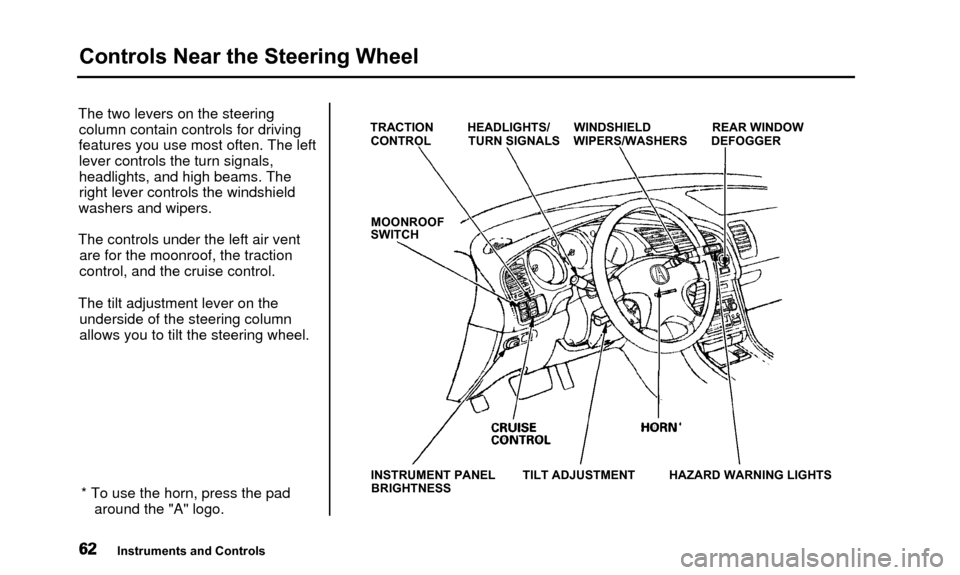
Controls Near the Steering Wheel
The two levers on the steeringcolumn contain controls for driving
features you use most often. The left lever controls the turn signals,
headlights, and high beams. The
right lever controls the windshield
washers and wipers.
The controls under the left air vent are for the moonroof, the traction
control, and the cruise control.
The tilt adjustment lever on the underside of the steering column
allows you to tilt the steering wheel.
* To use the horn, press the pad around the "A" logo.TRACTION HEADLIGHTS/ WINDSHIELD REAR WINDOW
CONTROL TURN SIGNALS WIPERS/WASHERS DEFOGGER
MOONROOF
SWITCH
INSTRUMENT PANEL TILT ADJUSTMENT HAZARD WARNING LIGHTS
BRIGHTNESS
Instruments and Controls
Page 72 of 311

Steeling Wheel Controls
Cruise ControlCruise control allows you to maintain
a set speed above 25 mph (40 km/h)
without keeping your foot on the accelerator pedal. It should be used
for cruising on straight, open
highways. It is not recommended for conditions such as city driving,
winding roads, slippery roads, heavy
rain, or bad weather. You should
have full control of the car under those conditions. Using the Cruise Control
CRUISE CONTROL MASTER SWITCH
1. Push in the Cruise Control Master
Switch to the left of the steering
column. The indicator in the
switch will light.
2. Accelerate to the desired cruising speed above 25 mph (40 km/h).
CONTINUED
Instruments and Controls
Improper use of the cruise
control can lead to a crash.
Use the cruise control only
when traveling on open highways in good weather.
Page 73 of 311

Steering Wheel Controls
RESUME/
accel
3. Press and release the SET/decel
button on the steering wheel. TheCRUISE CONTROL light on the
instrument panel comes on toshow the system is now activated. The cruise control may not hold the
set speed when you are going up and
down hills. If your speed increases
going down a hill, use the brakes to slow down to the desired speed. This
will cancel the cruise control. To resume the set speed, press the
RESUME/accel button. TheCRUISE CONTROL light on the
instrument panel comes on.
When climbing a steep hill, the automatic transmission may
downshift to hold the set speed.
Changing the Set Speed
You can increase the set cruisingspeed in any of these ways:
• Press and hold the RESUME/ accel button. The car will acceler-
ate. When you reach the desired
cruising speed, release the button.
• To increase your speed in very small amounts, tap the RESUME/
accel button repeatedly. Each time
you do this, your car will speed up about 1 mph (1.6 km/h).
• Push on the accelerator pedal. Ac- celerate to the desired cruisingspeed and press the SET/decel
button.
Instruments and Controls
Page 74 of 311
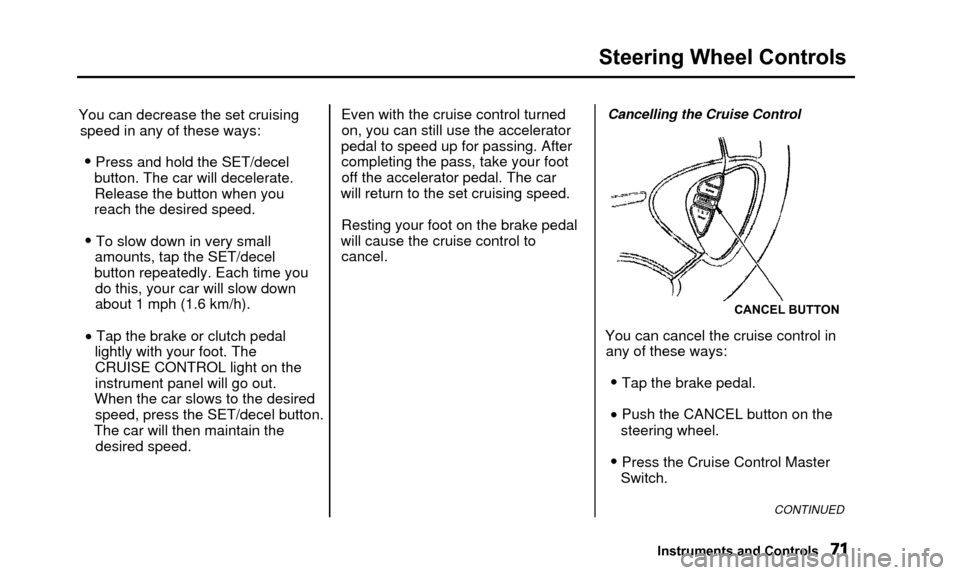
Steering Wheel Controls
You can decrease the set cruisingspeed in any of these ways:
• Press and hold the SET/decel button. The car will decelerate.Release the button when you
reach the desired speed.
• To slow down in very small amounts, tap the SET/decel
button repeatedly. Each time you do this, your car will slow down
about 1 mph (1.6 km/h).
• Tap the brake or clutch pedal lightly with your foot. TheCRUISE CONTROL light on the
instrument panel will go out.
When the car slows to the desired speed, press the SET/decel button.
The car will then maintain the desired speed. Even with the cruise control turned
on, you can still use the accelerator
pedal to speed up for passing. After completing the pass, take your foot
off the accelerator pedal. The car
will return to the set cruising speed.
Resting your foot on the brake pedal
will cause the cruise control to cancel.
Cancelling the Cruise Control
CANCEL BUTTON
You can cancel the cruise control inany of these ways:
• Tap the brake pedal.
• Push the CANCEL button on the
steering wheel.
• Press the Cruise Control MasterSwitch.
CONTINUED
Instruments and Controls
Page 75 of 311

Steering Wheel Controls
When you push the CANCEL button,or tap the brake pedal, the CRUISECONTROL light on the instrument
panel will go out and the car will
begin to slow down. You can use the accelerator pedal in the normal way.
The system remembers the previously-set cruising speed. Toreturn to that speed, accelerate toabove 25 mph (40 km/h) and then
press the RESUME/accel button until the CRUISE CONTROL lightcomes on. The car will accelerate to
the same cruising speed as before. Pressing the Cruise Control Master
Switch turns the system completely
off and erases the previous cruising
speed from memory. To use the
system again, refer to Using the Cruise Control Remote Audio Controls
AUDIO/CH
BUTTON
These buttons let you control some
functions of the audio system with-
out removing your hands from the
wheel. Refer to page 141 for a com- plete explanation.
Instruments and Controls
Page 155 of 311
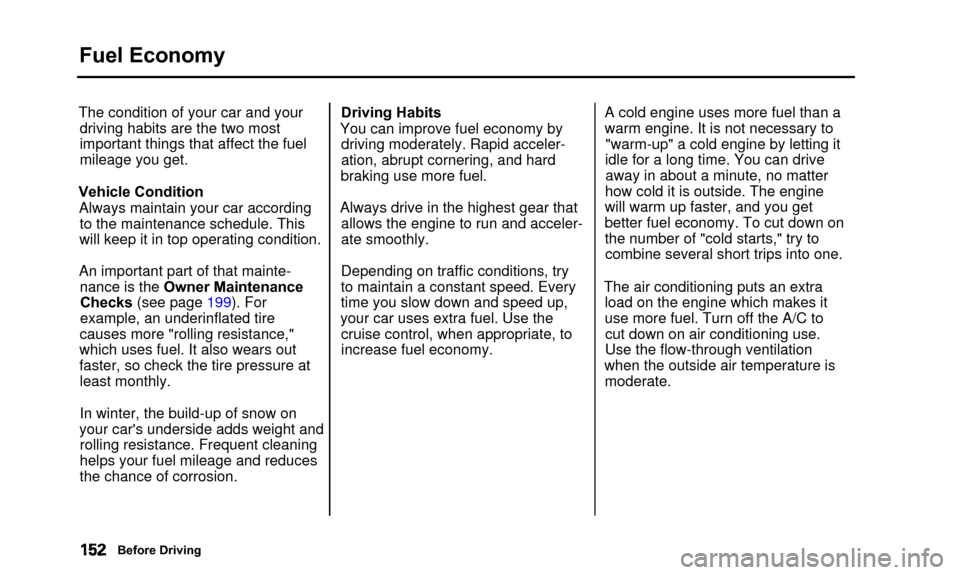
Fuel Economy
The condition of your car and yourdriving habits are the two most
important things that affect the fuel
mileage you get.
Vehicle Condition Always maintain your car according to the maintenance schedule. This
will keep it in top operating condition.
An important part of that mainte- nance is the Owner MaintenanceChecks (see page 199). For
example, an underinflated tire
causes more "rolling resistance,"
which uses fuel. It also wears out
faster, so check the tire pressure at least monthly.
In winter, the build-up of snow on
your car's underside adds weight and rolling resistance. Frequent cleaning
helps your fuel mileage and reduces
the chance of corrosion. Driving Habits
You can improve fuel economy by driving moderately. Rapid acceler-
ation, abrupt cornering, and hard
braking use more fuel.
Always drive in the highest gear that allows the engine to run and acceler-
ate smoothly.
Depending on traffic conditions, try
to maintain a constant speed. Every
time you slow down and speed up,
your car uses extra fuel. Use the cruise control, when appropriate, to
increase fuel economy. A cold engine uses more fuel than a
warm engine. It is not necessary to
"warm-up" a cold engine by letting it
idle for a long time. You can drive away in about a minute, no matter
how cold it is outside. The engine
will warm up faster, and you get
better fuel economy. To cut down on
the number of "cold starts," try to combine several short trips into one.
The air conditioning puts an extra load on the engine which makes it
use more fuel. Turn off the A/C tocut down on air conditioning use.Use the flow-through ventilation
when the outside air temperature is moderate.
Before Driving